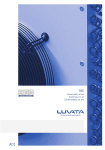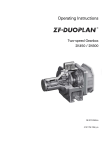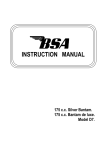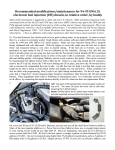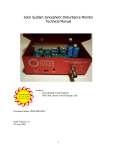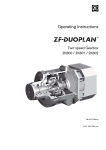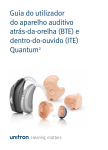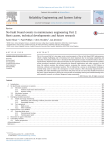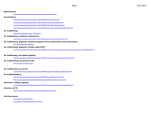Download Sprint Booster A technical white paper
Transcript
Sprint Booster A technical white paper Dick Bipes September 2007 Introduction Several Mercedes owners had installed a Sprint Booster in their cars and subsequently posted rave reviews about it. I wondered if all of their claims were true. Frankly, I was skeptical, but if these owners were on to something, I might want a Sprint Booster in my car! I also wanted to know how the Sprint Booster worked. I decided to investigate. The results of my investigation are presented here. The Sprint Booster is an aftermarket electronic module that plugs in between the accelerator pedal and the engine control unit (ECU) in vehicles equipped with an electronic throttle control. Many Mercedes, BMWs, Audis, and other vehicles sold today employ electronic throttle control, and more vehicles are going that way. The Sprint Booster web site makes these claims regarding electronic throttle control and the Sprint Booster: “The ECT system (Electronic Throttle Control) – also known as drive-bywire – has the unfortunate downside of delayed throttle response and subdued acceleration, creating problems in certain circumstances such as up-hill starts, quick gearchanges, overtaking, etc.” “The Sprint Booster aims to overcome this throttle response delay for ECT-equipped vehicles, providing crisp on-tap acceleration at the driver’s disposal.” "By installing the SPRINT BOOSTER, we eliminate the delay that occurs from the moment that the throttle is depressed and the electronic throttle control opens the butterfly, thus greatly improving the car's acceleration figures." Let’s see if these claims are substantiated. Background The throttle is a valve in the air intake that regulates the amount of air that the engine takes in. It is controlled by the accelerator pedal. We call the accelerator Sprint Booster – a technical white paper pedal the "gas pedal", but it does not regulate gasoline, it regulates air. Technically, I suppose we should call it the "air pedal", but that doesn't sound very macho. If a car has a carburetor, the carburetor meters fuel in response to the airflow, and if it is fuel injected, the ECU does this by controlling the injectors. In either case, more air results in more fuel, and more of both cause the engine to increase in speed and power. In conventional throttle systems, the accelerator pedal is connected to the throttle by a cable. In electronic throttle control systems, the accelerator pedal is connected to a sensor that sends a signal to the ECU. The ECU is connected to a servomotor that operates the throttle. In most cases, the ECU operates the throttle in proportion to the input from the accelerator pedal. However, in some cases, it does not. For example, in some Mercedes vehicles, Mercedes reduces the pedal sensitivity when driving in reverse, as explained in their service manual: “The pedal value sensor characteristic curve is changed if reverse travel is recognized by the control unit. The throttle valve opens more slowly. The entire opening angle in this case is approx. 50%.” In a vehicle equipped with traction or stability control, the ECU may close the throttle based upon wheel spin, or loss of traction, even if the accelerator pedal is not moved. The ECU also may limit throttle response in the case of a fault, such as engine overheating. In some vehicles, the ECU may alter the response of the throttle to the accelerator depending upon how the pedal is used, adapting to the driving style. For example, here is a description by Mercedes of what they call their adaptive accelerator pedal system in some of their vehicles: “The engine control unit recognizes how the accelerator pedal is being actuated and switches between characteristic curves. Eighty percent of the engine load is released for a pedal travel of about 50 % for a sporty driver and about 40 % for a quiet driver. There is no further difference felt above a pedal travel of about 90 %." Measurement Setup I measured the response of my car’s system both with and without a Sprint Booster installed. To measure my car's system, I connected a DATAQ DI-194RS data logger to the accelerator pedal sensor signal and the throttle position sensor (TPS) in my car. With a Sprint Booster plugged in, I also measured the output signal of the Sprint Booster. I logged measurements over several minutes’ time, driving under various conditions, such as relaxed and aggressive acceleration. My car is a 1999 Mercedes Benz SLK 230 with a manual transmission. In my car, the accelerator pedal sensor’s signal is a voltage of about 0.2 volts at rest and Bipes Page 2 September 2007 Sprint Booster – a technical white paper about 4.4 volts at full throttle. (There is a redundant signal at about half that amplitude which I did not record.) The TPS is about 0.7 volts closed and 4.6 volts open. On my charts, I have scaled these signals accordingly. Throttle response measurements The first measurements that I made were of the stock system without Sprint Booster. To map the throttle response to accelerator pedal, I slowly depressed the pedal over a period of about one and a half seconds. The resulting data log is in Figure 1. Figure 1: Stock accelerator pedal response In this graph, the blue line is the accelerator pedal sensor and the gray one is the TPS. If I had been perfectly smooth in pressing the accelerator pedal, the blue line would have been perfectly straight. Nonetheless, it’s close enough to make some observations about throttle response. Note that at ½ accelerator pedal depression, the TPS reads about ¼ of full value. At ¾ accelerator, the TPS is about ½. At full accelerator pedal to the floor, the TPS is full value. This nonlinear response is not surprising. The pedal is in effect less sensitive at the low end, probably what most people want for finer control under low-speed conditions. Next, to measure throttle lag, I pressed the accelerator pedal to the floor as fast as I could, held it, and then released it. See Figure 2. Bipes Page 3 September 2007 Sprint Booster – a technical white paper Figure 2: Stock system throttle lag Notice that it took me about 0.2 second to floor the pedal, and slightly less to release it. Looking at the delta between the blue and gray lines, notice also that actual throttle lag – the delay between pressing the accelerator and opening the throttle - is less than .1 second. What does this mean? Well, to overcome the mass of the accelerator pedal, and connected parts such as the return spring tension, to move the pedal through 3'' of travel took a finite amount of time, about 0.2 seconds. It is reasonable to assume that in a fully mechanical system, there would be a similar lag of at least 0.2 second to fully open the throttle. The electronic throttle control is adding less than 0.1 seconds to that. In the context of real-world throttle response – for example, 0-60 mph time – this small amount of extra time is not significant. I’d be very surprised if a typical driver could detect this small difference in time. This data makes me suspect that drivers of electronic throttle response vehicles who are noting throttle lag or poor throttle response are experiencing some behavior other than true throttle lag. At any rate, in my car, there is negligible actual throttle lag due to the electronic throttle control system, and consequently little if anything that a Sprint Booster could do to change this. Sprint Booster measurements I measured the response of a Sprint Booster model BDD 451A2 in my car. Using the same methodology as I did to measure accelerator pedal sensor and TPS response, I simultaneously logged accelerator pedal sensor, Sprint Booster output, and TPS. Bipes Page 4 September 2007 Sprint Booster – a technical white paper Figure 3 plots the accelerator pedal sensor versus Sprint Booster output. I measured the physical movement of the accelerator pedal to determine the ¼, ½, and 2/3 accelerator pedal depression points. Figure 3: Sprint Booster response Notice that up to about two-thirds accelerator pedal depression, the Sprint Booster signal is increased or multiplied over the accelerator pedal sensor signal, then becomes flat at maximum signal amplitude. This gives a good clue as to what the Sprint Booster is really doing. It is an amplifier, boosting the accelerator pedal sensor signal by about 30%. As further evidence of this, Figure 4 compares Sprint Booster output (in gray) against accelerator pedal sensor output (in blue), but with the voltage scales adjusted. The Sprint Booster output tracks the input with each and every change quite nicely, with a gain of about 1.3. Figure 4: Sprint booster versus accelerator pedal sensor Bipes Page 5 September 2007 Sprint Booster – a technical white paper What does this mean? Basically, the Sprint Booster makes the accelerator pedal about 30% more sensitive. A side effect, which can readily be seen in the graphs in Figure 3 and Figure 4, is that the accelerator pedal becomes dead beyond about two thirds travel with Sprint Booster. It is important to note that any accelerator signal into the ECU using a Sprint Booster can be duplicated exactly by a driver without a Sprint Booster, merely by pressing the accelerator pedal a greater distance. There is only one small exception, which will be covered later. Sprint Booster and throttle response I already noted that the stock electronic throttle control is very responsive. Let’s compare throttle response with and without Sprint Booster. Figure 5 shows rapid depression, hold, the release of the accelerator pedal with Sprint Booster installed. Bipes Page 6 September 2007 Sprint Booster – a technical white paper Figure 5: Sprint Booster throttle response The top graph plots accelerator sensor versus Sprint Booster. Consistent with what has already been observed, the two outputs are near identical at first, but the Sprint Booster output rises a bit faster and hits maximum value a bit sooner (less than .1 second) than the accelerator sensor. This is because the pedal more sensitive for the first two-thirds travel and ‘dead’ for the last third of its travel with Sprint Booster installed. The middle portion plots Sprint Booster output versus TPS. Compare this graph to the one in Figure 2. You can see that they are nearly identical, as would be expected. The bottom graph plots accelerator sensor versus TPS. Here, we see that initially the throttle response is virtually identical to that with no Sprint Booster connected. However, at the top 1/3 of accelerator pedal travel, where the pedal has now become "dead", the throttle response catches up to the accelerator Bipes Page 7 September 2007 Sprint Booster – a technical white paper position, gaining a bit over stock. Notice, however, that on releasing the accelerator, the reverse is true. Because the top 1/3 of the pedal is "dead", throttle response is lengthened by about .1 second. Using this information, does Sprint Booster improve throttle response and, as a result, yield faster acceleration? The Sprint Booster amplifies or increases the amplitude of the accelerator pedal signal. It directly affects only this one parameter, signal amplitude. It, in and of itself, doesn't really do anything faster. The speed at which things get done depends upon how fast the driver presses the accelerator pedal. So, we must know how fast the pedal is moving to see if things are happening faster. Let's consider what happens when we depress the accelerator pedal. We are moving the pedal over a unit of time. In my case, if I stomped on the pedal, I could get it to the floor in about 0.2 second. The accelerator pedal signal increases with travel. It will increase to maximum value in 0.2 second in this case. With the Sprint Booster in circuit, maximum value is reached at 2/3 travel. Converting to time, that would be 2/3 x 0.2 or about 0.13 seconds. So, we shaved off 0.07 in the time it takes to go to maximum value when flooring it. What if I took 0.3 seconds to floor it? With Sprint Booster, the ECU would see maximum accelerator signal in 2/3 x 0.3 or 0.2 seconds. But wait – that is exactly the same time as the stock case when I stomped on it! In fact, for any rate of accelerator pedal travel less than absolutely mashing it, as a driver I can duplicate the Sprint Booster result simply by pressing on the pedal a bit faster. The only time that the Sprint Booster can make anything happen faster is if I absolutely mash the pedal to the floor. Now, let's consider the throttle butterfly valve. It is driven by the ECU with inputs from the accelerator pedal and other sources. Since in all cases but mashing the pedal I can duplicate the Sprint Booster signal to the ECU just by moving the pedal a bit more, I can make the throttle move equally fast or slow with or without the Sprint Booster. I just need to adjust the way I modulate the pedal. The one time that I can't duplicate Sprint Booster is mashing the pedal. OK, so what about thos times when I do mash the pedal to the floor? If you examine the TPS curves carefully, you'll see that with or without Sprint Booster, when mashing the accelerator pedal the throttle butterfly valve moves equally as fast for about the first half of its travel. It's only when the throttle is more than half open does it actually move a bit faster with Sprint Booster. The Sprint Booster speed gain when mashing the throttle is 0.07 second, so 0.07 x ½ travel is 0.035 second. With Sprint Booster, the throttle is open wider for 0.035 second. How much wider? Only a small fraction wider than the stock case at any given point in its travel. In theory, that would translate into a faster 0-60 acceleration Bipes Page 8 September 2007 Sprint Booster – a technical white paper figure of something less than 0.035 second. In actuality, the increase is so small that it is not measurable. Sprint Booster does not improve throttle response or acceleration. Sprint booster and adaptive throttle Several Sprint Booster users have complained about the adaptive throttle in their vehicles with an electronically controlled throttle. They claim that performance becomes sluggish over time, and that using a Sprint Booster overcomes this. Knowing that Sprint Booster is nothing more than an amplifier of the accelerator pedal sensor signal, it’s hard to understand this claim. Let’s look into this. A lot of people speculate on exactly what the adaptive control in their vehicle is or does. There is precious little information readily available on this subject. I was able to get the following information from the Mercedes service manual through my subscription to alldatadiy.com: "Adaptative accelerator pedal (model 203, 209, 211, 215, 220, 230): “The engine control unit recognises how the accelerator pedal is being actuated and switches between characteristic curves. Eighty percent of the engine load is released for a pedal travel of about 50 % for a sporty driverer and about 40 % for a quiet driver. There is no further difference felt above a pedal travel of about 90 %. "Note: If, for example, the characteristic curve for a quiet driver is active after a long drive on the motorway then the accelerator pedal must be pressed down unusually hard to obtain a higher acceleration level." So, the ECU actually does on its own what the Sprint Booster does. It changes the gain or response to the accelerator pedal. However, unlike the Sprint Booster, which applies a fixed gain, in these Mercedes applications the ECU varies the gain between at least two "characteristic curves". OK. If I've been driving my stock Mercedes on the motorway or freeway a long while, the ECU switches to the "quiet driver" curve. Of course, as the driver, I have no indication of this. Now, if I want to pass, and I press the pedal down a bit, say to the 70% point, what do I get? Because I'm on the "quiet" curve, I would get 40% power at 50% pedal, so I suppose I get maybe 60-70% power at 70% pedal (we don't know because Mercedes doesn't tell us). But, if I have a Sprint Booster installed, now what happens? The Sprint Booster multiplies the 70% pedal by 1.3 to 91%. I'm still on the quiet curve, but since there's no difference between curves above 90% pedal travel (and that's what the ECU got from the Sprint Booster), boom – I get 90+% power. "Feels" great. Note that Mercedes tells me that I could Bipes Page 9 September 2007 Sprint Booster – a technical white paper get the same 90+% power without the Sprint Booster, I just need to hit 90% pedal. But, of course, that "feels" more sluggish. The car is not more sluggish - it "feels" that way. This is, in essence, what Sprint Booster is all about – feel. Here is another consideration regarding feel. On some Mercedes vehicles, a kickdown switch is used. This is a switch on the accelerator pedal that is activated on full accelerator pedal depression. The switch feeds into the control module for automatic transmissions. As the name implies, it is one input to tell the automatic transmission to downshift for quicker acceleration. It has a tactile feel to it – you can feel the switch, and need to increase pressure on the accelerator pedal a bit to overcome it, so you know by feel when you are engaging it. Here’s a little tidbit of information from Mercedes: “The kickdown switch was no longer used from 9/01. Recognition of full load is now achieved over the signal from the pedal value sensor. The pressure point on the accelerator pedal before achieving the full load position remains.” OK. So, what happens if I have a vehicle equipped with tactile kickdown feedback, but no actual switch? If I’m cruising along, then want to pass, and I push the accelerator pedal down to 70% as before, the kickdown switch does not engage. The engine speeds up, but slowly, as does the vehicle, because the automatic transmission remains in top gear. “Hmm – sluggish!” I might think. I press harder, hit the tactile point, press harder still, and engage kickdown. “Finally” I think, as the transmission finally downshifts, and I accelerate to pass. Now, what happens when I use Sprint Booster? I press the accelerator pedal down a bit, not so much as to engage the kickdown tactile feedback (just like I originally did before), but enough to hit the kickdown full-signal threshold. (Remember, the Sprint Booster multiplies the signal and hits full value at only two-thirds pedal depression, so I don’t have to press very much.) Boom! Kickdown, downshift, full throttle, and I’m off accelerating at maximum. “Wow! That Sprint Booster is amazing! Look at all the power it gave me!” I might think. Of course, I could have had the exact same power and transmission downshift had I just pressed harder in the first place. But, if I didn’t know better, I’d probably swear that the Sprint Booster overcame the ECU’s adaptive nature. Some have speculated that the Sprint Booster keeps you in "sporty" mode, but based on Mercedes' description, I question that. I think that the Sprint Booster just overcomes "quiet" mode without the aggressive step down. With little factual information is available regarding manufacturer’s adaptive controls, there is lots Bipes Page 10 September 2007 Sprint Booster – a technical white paper of speculation on how it works. This only fuels speculation on what Sprint booster actual does. What is the Sprint Booster? I did not disassemble the Sprint Booster in my possession, as it was on loan to me. But it appears to be nothing more than an amplifier. My guess is that it is a pair of op amps is employed to simply multiply the two accelerator sensor signals by 1.3. My further guess is that the difference between the various models of Sprint Booster is the amount of gain, which would be set by a few resistors in the circuit. Even in low volume production, I estimate the cost of the electronics to be less than $5, and total parts cost of the unit to be less than $25. With a retail price upwards of 10 times that amount, the Sprint Booster is probably a very profitable product. Incidentally, if I were permanently installing this device in my car, I would want the Sprint Booster to have two completely independent amplifiers. Why? Mercedes wisely used two independent accelerator pedal position sensors for the ECU to sample. In this manner, a single point of failure can both be detected by the ECU (a check engine light and code) and worked around (driven normally). If the Sprint Booster does not use independent circuits, a single point of failure could affect both outputs, rendering the car inoperative or telling the ECU to floor it, neither of which might be detected by the ECU as a fault. This is unlikely perhaps, but not impossible. Addendum Another enthusiast sent me a different version of the Mercedes Sprint Booster for analysis. As you can see by the attached graph, the two versions basically do the same thing; one just amplifies the accelerator sensor signal more than the other. Bipes Page 11 September 2007 Sprint Booster – a technical white paper I ran across this link in MBWorld.org forums explaining the two models. Here is the text from that link: After long talks with Stamatis Boulekos I have learned that there are only two versions for MB and if you purchase yours from them or a authorized dealer you will not get the old aggressive version, it simply is not made anymore. You can tone down a manual trans by using the automatic version but that is the only difference, one for manual and one for automatic. This is from the owner of the company, Der Mr Werner, There are two Versions for MB. One is for automatic transmission models and one version is for manual transmission models. The part for manual transmission can only be installed in manual cars ,the part for automatic can be installed in automatic cars but also can be used in manual cars as a ''lighter'' version if someone wants the acceleration less sharp than the ''sharper'' manual version . Best Regards Stamatis Boulekos I hope this answers your question. Of course the so-called manual model can indeed be installed in an automatic car, as the connectors are identical. It’s just that the accelerator pedal may be overly sensitive. But who knows, maybe some people would like it that way. Bipes Page 12 September 2007 Sprint Booster – a technical white paper Conclusions The Sprint Booster is a simple amplifier that multiplies the accelerator pedal sensor signal, making the accelerator pedal more sensitive. It does not eliminate any significant delay in throttle response, nor does it greatly improve acceleration figures. It does not change the adaptive throttle control programming of electronic throttle control vehicles. It does change pedal “feel”. This change in feel is interpreted by some as improved throttle response, acceleration, and a change in adaptive throttle control programming. Considering what it actually does, it is expensive. Bipes Page 13 September 2007













